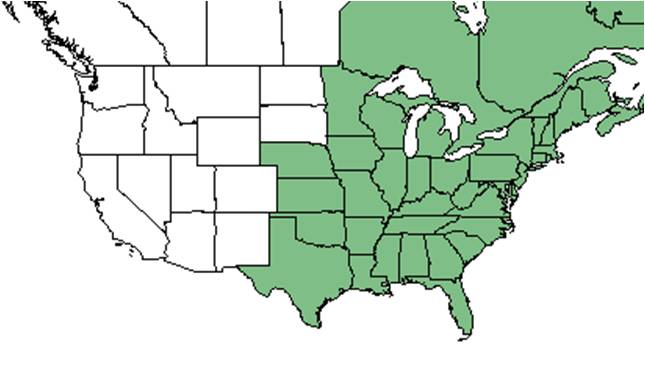Difference between revisions of "Galium tinctorium"
KatieMccoy (talk | contribs) (→Description) |
KatieMccoy (talk | contribs) |
||
| Line 31: | Line 31: | ||
===Phenology=== <!--Timing off flowering, fruiting, seed dispersal, and environmental triggers. Cite PanFlora website if appropriate: http://www.gilnelson.com/PanFlora/ --> | ===Phenology=== <!--Timing off flowering, fruiting, seed dispersal, and environmental triggers. Cite PanFlora website if appropriate: http://www.gilnelson.com/PanFlora/ --> | ||
| − | ''G. tinctorium'' flowers March through May and fruits April through August (FSU Herbarium). | + | ''G. tinctorium'' flowers March through May and fruits April through August (FSU Herbarium). Fruits are a pair of tiny, smooth round pods, each containing a seed<ref name="minnesota"/>. |
===Seed dispersal=== | ===Seed dispersal=== | ||
Revision as of 19:34, 15 December 2015
| Galium tinctorium | |
|---|---|
Error creating thumbnail: Unable to save thumbnail to destination
| |
| Scientific classification | |
| Kingdom: | Plantae |
| Division: | Magnoliophyta - Flowering plants |
| Class: | Magnoliopsida - Dicotyledons |
| Order: | Rubiales |
| Family: | Rubiaceae |
| Genus: | Galium |
| Species: | G. tinctorium |
| Binomial name | |
| Galium tinctorium (L.) Scop. | |

| |
| Natural range of Galium tinctorium from USDA NRCS Plants Database. | |
Common name: stiff marsh bedstraw
Contents
Taxonomic notes
Description
A perennial plant with 5-6 whorled dark green leaves per node along the stem [1]. Roots are fibrous and rhizomatous. Flowers are radially symmetrical and are in clusters of three arising from leaf axiles and at the end of branching stems [2].
Distribution
Ecology
Habitat
In the Coastal Plain in Florida and Georgia, G. tinctorium has been found in cabbage palm hammocks, boggy depressions in coastal hammocks, bordering lakes, wet pine flatwoods, cypress swamps, river banks, Nyssa bottomlands, longleaf pine/saw palmetto flatwoods, sweetbay swamps, and bordering salt marshes. It can also occur in human disturbed areas such as roadside ditches, gas pipeline corridors, shores of drainage canals, and roadside seepage zones (FSU Herbarium). Soil types include sandy loam, loamy clay, and clayey sand (FSU Herbarium). Associated species include Lilaeopsis carolinensis, Typha latifolia, Hydrocotyle umbellata, Fraxinus, Liquidambar, Acer, Gleditsia, Nyssa, Ulmus, and Carpinus (FSU Herbarium).
Phenology
G. tinctorium flowers March through May and fruits April through August (FSU Herbarium). Fruits are a pair of tiny, smooth round pods, each containing a seed[2].
Seed dispersal
Seed bank and germination
Fire ecology
Pollination
The following Hymenoptera families and species were observed visiting flowers of Galium tinctorium at Archbold Biological Station (Deyrup 2015):
Vespidae: Leptochilus alcolhuus
Use by animals
Diseases and parasites
Conservation and Management
Cultivation and restoration
Photo Gallery
References and notes
Deyrup, M.A. and N.D. 2015. Database of observations of Hymenoptera visitations to flowers of plants on Archbold Biological Station, Florida, USA.
Florida State University Robert K. Godfrey Herbarium database. URL: http://herbarium.bio.fsu.edu. Last accessed: October 2015. Collectors: : Loran C. Anderson, George R. Cooley, M.W. Cullen,R. J. Eaton, J.P. Gillespie, R.K. Godfrey, Richard D. Houk, J.M. Kane, R. Kral, R.B. Ledin, Robert J. Lemaire, S.W. Leonard, William Lindsey, Sidney McDaniel, R.C. Phillips, James D. Ray, P.L. Redfearn , Grady Reinert, Paul O. Schallert, Cecil R. Slaughter, John K. Small, E. Smith, J.N. Triplett Jr., C.E. Wood. States and Counties: Florida: Alachua, Brevard, Citrus, Clay, Collier, Columbia, DeSoto, Flagler, Franklin, Gadsden, Gulf, Hamilton, Highland, Hillsborough, Holmes, Indian River, Jefferson, Leon, Levy, Liberty, Marion, Martin, Nassau, Orange, Polk, Putnam, Santa Rosa, Seminole, St. Johns, Union, Wakulla, Washington. Georgia: Thomas. Compiled by Tall Timbers Research Station and Land Conservancy.